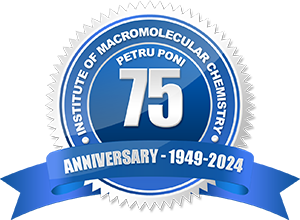|
Aim of the project: the use of linear and / or crosslinked natural or synthetic ionic polymers - synthesized especially within our research group - in the development of nanostructured composite materials by various methods:
(1) suspension polymerization
(2) auto-assembly by physical interaction
(3) in vitro mineralization of calcium carbonate and various ionic support materials
and testing new materials in applications such as environmental protection and medicine.
Important results:
- Porous materials obtained by grafting of polysaccharides (xanthan, gellan, chitosan, sodium hyaluronan) onto crosslinked networks based on glycidyl methacrylate
The aqueous suspension polymerization is one of the most common techniques used for the preparation of porous microparticles due to some advantages, such as: small number of reagents in comparison with emulsion polymerization or other techniques; ability to control the size and size distribution of microparticles; simple purification method (filtration, centrifugation) for the final product; lower cost compared to a broad spectrum of properties acquired by the microparticles; excellent heat transfer during the process. A combination between synthetic (glycidyl metacrylate and dimethacrylic monomers) and natural polymers (xanthan, gellan, chitosan, sodium hyaluronan) could lead to the new polymeric materials that can combine the specific properties of synthetic polymers like: chemical stability and resistance at different values of pH and temperature with the special properties of natural polymers such as biodhesion, biocompatibility and biodegradability.
- Silica / polyelectrolyte multilayer composites and subsequent interaction with dyes (eg. green bromcrezol) with multilayer polyanion extraction
- Calcium carbonate morphogenesis in the presence of macromolecular compounds, depending on different parameters: nature, concentration and type of polymer functional groups, inorganic concentration, pH of the medium, reaction time.
- Obtaining ion exchangers in two phases:
(1) obtaining acrylic precursors crosslinked by the aqueous suspension copolymerization process of vinyl monomers (ethyl acrylate, acrylonitrile, vinyl acetate etc.) in the presence of a crosslinking agent (divinylbenzene) and an inert medium (toluene, etc.)
(2) the chemical modification of the precursors by polymer-analogous reactions of aminolysis, hydrolysis and carboxymethylation in order to obtain weak basic, weak acid and amphote ion exchangers
|








